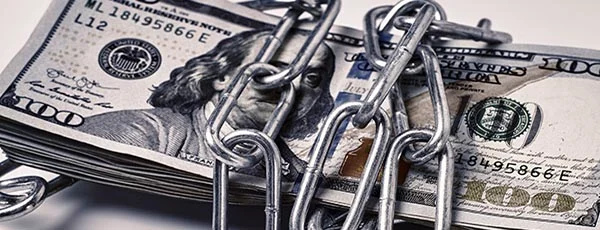Recovering from a Contractor Gone Wrong…Without Bankruptcy

UpdatedJul 2, 2025
- Over a quarter of homeowners have had a bad experience with a contractor.
- Almost half of homeowners with contractor issues lost $1,000 or more.
- Be proactive in dealing with a bad contractor to protect your finances and avoid foreclosure or bankruptcy as a result of the costs of fixing an error.
Table of Contents
Home improvement projects can increase the value of your property and make your home a more livable place to be—if all goes well. Unfortunately, it doesn't always.
But you can recover when things go wrong, and avoid derailing your financial future. You just need to know how to deal with a contractor gone wrong. Here are some tips, along with details of how this writer solved contractor problems.
Research from a JW Surety Bonds study revealed that 28% of homeowners who have hired a contractor experienced problems with their project. Among those who had an issue, nearly half lost $1,000 or more. Unfortunately, serious contractor mistakes can sometimes cost much more than $1,000, and homeowners left to fix major issues could find themselves deeply in debt, risking foreclosure, facing bankruptcy, or in desperate need of a debt relief program. Even then, you do have options.
How I Coped When Working with a Contractor Went Wrong
When I decided to do a gut renovation after buying a Florida home, I made a budget plan and paid for as much as possible out of savings. I interviewed contractors, asked for referrals, checked references, and saw the contractor's work in person.
Unfortunately, things quickly went wrong. The kitchen cabinets came back more than $100,000 over the budget. The contractor couldn't get hot water from the new water heater. Pipes fell off a newly installed sink. Light fixtures didn't turn on. And that’s just the start of a long list.
In light of all that, I withheld some of the payments to cover the cost of bringing in other experts to make fixes. I documented everything so I had clear proof of poor work in case they tried to collect payment from me that I wasn't comfortable making. I also gave them deadlines to finish the work before I'd leave a bad review.
My contractor problems have remained unresolved for over a year, but my financial goals haven't been derailed, and I'm not at risk of bankruptcy or foreclosure. That’s because I didn't pay for work until it was inspected, and I'm confident I have sufficient documentation to take legal action if the contractor doesn't ultimately correct the issues.
How to Deal with a Contractor Gone Wrong
As the data shows, I'm far from the only one who’s coped with a problematic construction crew. If you're trying to figure out how to deal with a contractor who is not delivering work up to your standards, steps you can consider taking include:
Don’t agree to pay until the job has been completed to your satisfaction. This is harder if you initially sign a contract that has other payment terms, so it’s something that’s better to pay attention to during the contractor selection and hiring process.
Hire other professionals to fix the problems, and subtract the cost from the amount still due to the contractor who made the errors.
Keep a careful record of issues and set deadlines for fixes, or at least for milestones.
Communicate regularly with the contractor, and keep copies of your correspondence.
Inform the contractor that you intend to report the issues to the licensing board and leave poor reviews online if issues aren't corrected—and follow through if things aren't fixed.
Get legal advice. Often, when an attorney sends a demand letter to the contractor, that's enough to get them to step up their service and correct problems. If not, your attorney can help you explore using the civil justice system to recover lost funds.
Pursue a claim through dispute resolution via mediation, arbitration, or litigation. With mediation, you and the contractor agree to a course of action. With arbitration, you avoid court, and an arbitrator decides what should happen. With litigation, you go before a court for a judicial decision, and your case becomes public record.
Taking some or all of these steps can hopefully get your project back on track so you avoid major financial loss.
How to Cope Financially with a Bad Contractor
Studies show that contractor mistakes are common and costly, so many of us end up with big bills due to contractor problems. This could happen if:
You pay a contractor for work not performed properly and on schedule (or performed at all), and you have to pay someone else to make fixes. This might even double (or more) the costs of your home improvement project.
The contractor causes substantial damage to your home, making very expensive fixes necessary.
In these situations, you may need to spend thousands (or even tens of thousands) of dollars to complete the work up to code and protect your home's value. Chances are good you won't have enough in your emergency fund to cover such large unexpected expenses—especially if you stretched your budget to pay for the work in the first place.
How to deal with a contractor gone bad may not be immediately obvious when it comes to finances, but you do have options. These include:
Saving up for fixes: You can fix each issue that the contractor caused as you save up money over time.
DIYing what you can to get back on track: Making some repairs yourself could help you keep costs down—and help you avoid another bad contractor. Just be sure you have (or gain) the knowledge to improve the situation.
Using a personal loan: Personal loans can be used for any reason, including paying for home repairs or upgrades after a contractor causes issues.
Taking out a home equity loan or home equity line of credit: Home equity loans or HELOCs involve taking a secured loan that uses your home to guarantee the debt. The rates are usually more affordable than personal loan rates, but you risk losing your home if you don't repay the loan as agreed. If you use your loan to fix your house, interest may be at least partly tax-deductible depending on the amount you borrow and whether you itemize.
Charging items on your credit card: You can use your credit card to pay for some things (like raw materials), although contractors usually don’t accept credit cards because of high transaction fees. Using a credit card is often not the best idea anyway, unless you can pay off the balance in full before you have to pay interest.
Borrowing against retirement accounts: If you have a 401(k), you may be able to take a loan against it. This can be an affordable borrowing solution since you pay yourself back, and it’s one you can qualify for even if your credit isn't perfect. However, you miss out on investment gains by having money out of the market.
Saving is usually the best of these options, but it isn't always possible if your bad contractor caused a health or safety issue in your home, such as exposing you to asbestos or weakening the home's structure.
In situations where you must act quickly, you typically need to DIY or borrow. If you have to borrow, find the most affordable low-interest loan that doesn't expose you to unacceptable risk.
What if You're Left Deeply in Debt by a Bad Contractor?
If an issue with a contractor left you deeply in debt, you may be at risk of foreclosure or considering bankruptcy. These options don’t always allow you to escape your debt, however.
In a foreclosure, you lose your home. If it sells for more than what you owe, you could end up with cash from the sale. If it sells for less, the mortgage lender may get something called a deficiency judgment against you, which is a legal order to pay back the difference.
If you file for bankruptcy, you can't get free of your mortgage unless you give up the home. You might be able to get free of a second mortgage or home equity loan if the home is worth less than you owe on your primary mortgage.
Before you decide to file for bankruptcy or stop making mortgage payments and risk foreclosure, explore debt relief options like debt settlement or a debt management plan. Getting professional help may also be a good idea, so learn how Freedom Debt Relief works to see if it might be right for you.
Debt relief by the numbers
We looked at a sample of data from Freedom Debt Relief of people seeking credit card debt relief during May 2025. This data reveals the diversity of individuals seeking help and provides insights into some of their key characteristics.
Credit Card Usage by Age Group
No matter your age, navigating debt can be daunting. These insights into the credit profiles of debt relief seekers shed light on common financial struggles and paths to recovery.
Here's a snapshot of credit behaviors for May 2025 by age groups among debt relief seekers:
| Age group | Number of open credit cards | Average (total) Balance | Average monthly payment |
|---|---|---|---|
| 18-25 | 3 | $8,864 | $274 |
| 26-35 | 5 | $12,615 | $380 |
| 35-50 | 6 | $16,479 | $431 |
| 51-65 | 8 | $17,240 | $528 |
| Over 65 | 8 | $17,811 | $498 |
| All | 7 | $15,142 | $424 |
Whether you're starting your financial journey or planning for retirement, these insights can empower you to make informed decisions and work towards a more secure financial future
Personal loan balances – average debt by selected states
Personal loans are one type of installment loans. Generally you borrow at a fixed rate with a fixed monthly payment.
In May 2025, 44% of the debt relief seekers had a personal loan. The average personal loan was $10,718, and the average monthly payment was $362.
Here's a quick look at the top five states by average personal loan balance.
| State | % with personal loan | Avg personal loan balance | Average personal loan original amount | Avg personal loan monthly payment |
|---|---|---|---|---|
| Massachusetts | 42% | $14,653 | $21,431 | $474 |
| Connecticut | 44% | $13,546 | $21,163 | $475 |
| New York | 37% | $13,499 | $20,464 | $447 |
| New Hampshire | 49% | $13,206 | $18,625 | $410 |
| Minnesota | 44% | $12,944 | $18,836 | $470 |
Personal loans are an important financial tool. You can use them for debt consolidation. You can also use them to make large purchases, do home improvements, or for other purposes.
Tackle Financial Challenges
Don’t let debt overwhelm you. Learn more about debt relief options. They can help you tackle your financial challenges. This is true whether you have high credit card balances or many tradelines. Start your path to recovery with the first step.
Show source
Author Information

Written by
Kimberly Rotter
Kimberly Rotter is a financial counselor and consumer credit expert who helps people with average or low incomes discover how to create wealth and opportunities. She’s a veteran writer and editor who has spent more than 30 years creating thousands of hours of educational content in every possible format.



